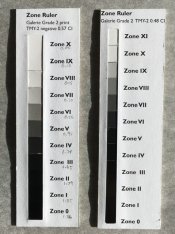Maybe this is related here, but someone wrote somewhere that humans are bad at differenting shadow details but really good at noticing differences in highlights. Or was it vice versa

Whatever it was (correct if someone remembers which way it was), it explains why some want to "loose" shadows or blow out the highlights.
It was me who said that, and it was loosely based on what Ctein wrote in Post Exposure:
http://ctein.com/PostExposure2ndIllustrated.pdf See page 5 bottom left, but the argument continues on the next page with some more nuance. Basically, in general, our eyes are less apt at distinguishing very dark tones that are quite close to each other in density than we are at discerning very light values with small density variations. However, this does depend quite a bit on ambient lighting; at very high light levels (think of bright sunlight) the opposite becomes true and we have a hard time telling 'shades of white' apart, but it's easy to see differentiation in blacks. Apart from this, the color of the light and the viewing angle also have an influence. It's in fact pretty complex, but for 'average' viewing conditions (insofar this exists), it works fairly well to stick with 'we are not so good at differentiating blacks, but quite good at differentiating whites'.
However, all this cannot (in my opinion) be simplified to 'we can sacrifice either the shadows or the light values' and therefore allow blacks to fill in or whites to blow out. The implication is, at least for me, in my printing, that I need only a relatively small amount of differentiation (in absolute density terms) in the light values to distinguish, say, the tonality of clouds or the gradient of a bright sky, or the line between a bright sky and the white border of the print. On the other hand, I need quite significant differentiation in the shadows so that I can easily differentiate the shadow values and spot the person standing underneath the trees, see the dimly lit water plants against the inky black water itself, etc.
In terms of choosing between blowing out highlights and allowing shadows to fill in, it really depends - on the situation/desired result, and of course very much on personal preference. For me, personally, insofar as there is a rule, it would be that if it's larger areas, I'm more comfortable with shadows filling in than with highlights blowing out, as I find a fairly large shadow area in many cases (think of low-key scenes) not particularly bothersome, whereas for example a completely blown out sky or cloud portion is just (again, to me - subjectively) massively annoying. It is different for very small areas; when talking about e.g. specular highlights (typical example: small reflections of bright lights on shiny surfaces such as polished metal or a water surface), they come out best if they are pure white or very close to it - but only so if they are surrounded by a larger area of distinctly darker tones.
From all this you can take that, as 138s says, it's very much a creative decision and therefore personal and subjective, and that there is no really hard and fast rule to be concluded. If you will (referring to another thread of yours): dogma is kind of difficult to hold up in this particular area. I'd say that the only 'dogma' I would dare to put forth is that "there cannot be a dogma that allows either to blow out highlights or fill in shadows as a default approach" - it just depends too much on the image and its maker.





